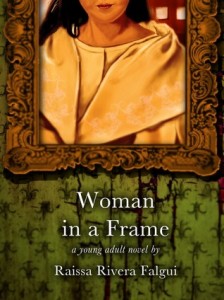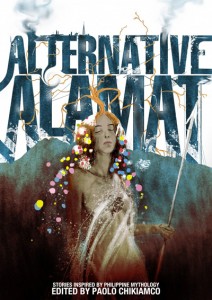 Woman in a Frame by Raissa Rivera-Falgui
Woman in a Frame by Raissa Rivera-Falgui
Publisher: Flipside Publishing
Number of pages: 107
My copy: ebook review copy from publisher
In a darkened hall in a plain white box of a building was a portrait of a woman, a girl, really—an old-fashioned girl in a modern frame, leaning against the wall. Other paintings similarly arrayed surrounded her, waiting to take their places in the gallery.
Voices echoed in the room, a young man’s jeering and a young woman’s more tentative tones. Cool hands with long, delicate fingers lifted the portrait.
Perhaps what drew the young woman to this painting was the incongruity of a girl, grave and formal, set within the vibrant, flowing curves of the carved art nouveau frame. Perhaps it was the sense of kinship she felt. For the young woman, Ning, was the daughter of an artist, dreaming of becoming an artist. She knew nothing of the girl in the portrait, only that the intensity captured in the glimmer of its brush-stroked eyes reflected her own.
So begins Ning’s journey to her country’s colonial past to uncover the story behind the portrait—the story of Marcela.
It is 1896, and Marcela, of the renowned Simbulan artist family from Pino, Laguna, has fallen in love with Julio Benitez, a Spanish peninsular just come from Europe to woo the town’s belle: Raquel Riola, mestiza heiress. Torn between loyalties to family and nation, desire and social expectations, childhood and maturity, Marcela must learn to navigate dreams and deceptions to free her silenced love and stifled craft.
* * *
I’m not a huge fan of historical novels, really. I tend to stay away from them because they’re just not my type. Of course, there were some that I enjoyed, namely Jennifer Donnelly’s books, The Guernsey Literary …,and yeah, even Jose Rizal’s Noli Me Tangere, which I really attribute to the fact that these books had personal significance for me (A Northern Light had things about words, Revolution because of Paris, Guernsey because of the recommendations, and Noli Me Tangere because it was a Filipino historical novel), but other than that, I had no reasons to pick them up. They’re almost like classics to me — hard to get into, and really not my cup of tea. But I can make exceptions, especially since I did say I want to read more Filipino fiction, so when the publisher offered a review copy of Raissa Rivera-Falgui’s Woman in a Frame to me, I decided to give it a try.
Woman in a Frameintroduces Ning, short for Sining, who is a daughter of an artist and dreams of becoming an artist herself. Thanks to her deceased father’s connections, she was able to attend a summer art program where she stumbles upon a very curious painting of a woman who feels very familiar to her. Curious, Ning searches for the artist and the story behind the painting. In 1896, Marcela, a young artist from the Simbulan artist family joins her father to paint the town’s darling, Raquel Riola. Raquel is set to marry Julio Benitez, a Spanish peninsular from Europe. Marcela develops a friendship with Raquel, but also falls in love with Julio. She is faced with choosing between her family, new friend and her love, the social differences between her and Julio and a possible involvement in a brewing revolution against the government.
I liked Woman in a Frame. I wasn’t expecting it especially since I wasn’t really captured in the first chapter, but as I read on, I fell in love with Marcela and the Simbulan family and their life in 1896. I can imagine the afternoons where Marcela and her father would be at the Riola mansion to do their job, and how a Filipina and a half-Spanish girl would walk in the afternoons and chatter over things despite their differences. I’m not an artsy person, but I can vividly imagine the kind of art that the Simbulan family makes, and how it could become their living. I liked Marcela as a character, and her loyalty to her family and her friendship, and how she dealt with her affection for Julio. It was quite refreshing — she’s far from timid and shy Maria Clara, but more of a Sinang from Noli Me Tangere, especially with what she did in the end.
I think it was the freshness of Noli in my mind that helped me visualize the setting and in the novel, so it almost felt I was just focusing on another character in Noli when I was reading Woman in a Frame. A spin-off, if you may. There were the friars and the brewing revolution, but it didn’t take over the story and turn Marcela into a young Katipunera as I almost expected it to be. I’m glad it didn’t turn out that way, because I didn’t know if I’d like that turn! I liked the bittersweet feeling of the first love, and how it all unfolded in the end. The synopsis had that Filipino soap opera feel when you think about it, but it had a pretty interesting turn of events that wasn’t dramatic at all.
My only wish is that there was more Ning in the story! The story reminded me a lot of the dual narrative in Revolution but it lacked what that novel had — the dual narrative. I enjoyed the Marcela story, but I wished that we got to see Ning more since this was also her story. Okay, fine, it was more of Marcela’s story, but I just really wished we had more of present time and Ning, and not just some sort of info dump at the end tying up the connections between her and Marcela.
I still liked Woman in a Frame despite that little nitpick, though! I think historical fiction fans will like it, and it’s a quick enough read and get lost in in a day. It also gives readers a good insight on Filipino artists and how regular people were a part of the revolution. And…yeah, the romance factor is pretty satisfying, too. :) Woman in a Frame by Raissa Rivera-Falgui is available in ebook format from Flipreads store, Amazon, Kobo and iTunes. Thanks to the publisher for the review copy! :)
Rating: [rating=3]

